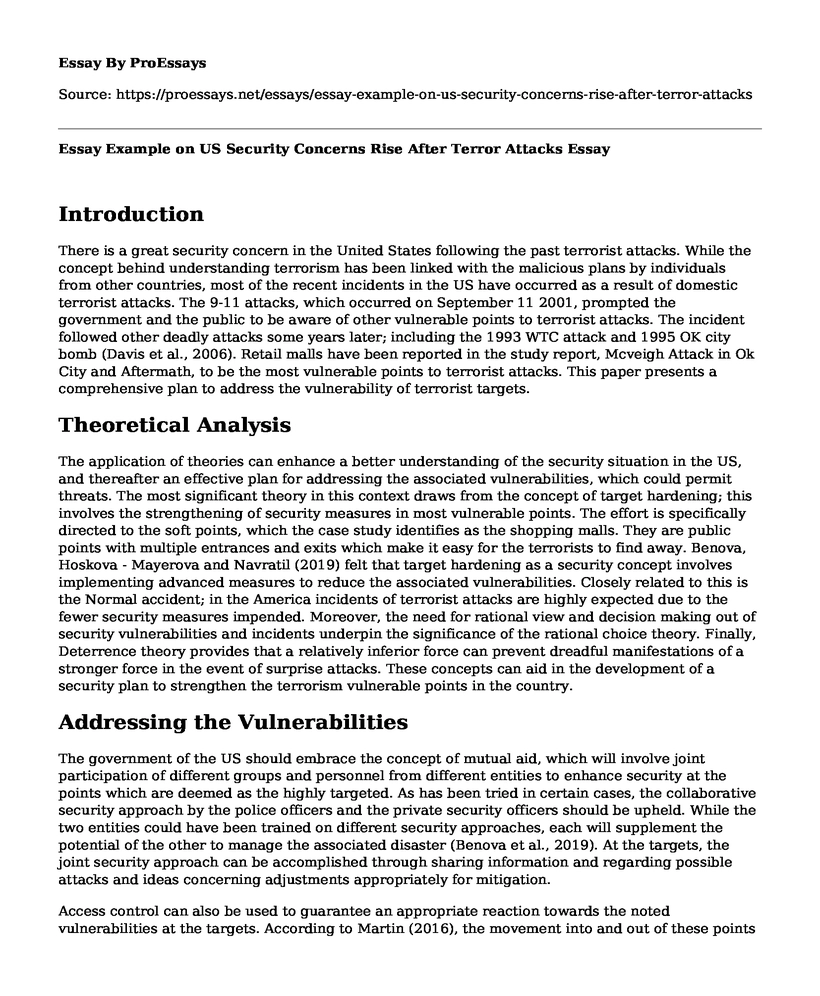Introduction
There is a great security concern in the United States following the past terrorist attacks. While the concept behind understanding terrorism has been linked with the malicious plans by individuals from other countries, most of the recent incidents in the US have occurred as a result of domestic terrorist attacks. The 9-11 attacks, which occurred on September 11 2001, prompted the government and the public to be aware of other vulnerable points to terrorist attacks. The incident followed other deadly attacks some years later; including the 1993 WTC attack and 1995 OK city bomb (Davis et al., 2006). Retail malls have been reported in the study report, Mcveigh Attack in Ok City and Aftermath, to be the most vulnerable points to terrorist attacks. This paper presents a comprehensive plan to address the vulnerability of terrorist targets.
Theoretical Analysis
The application of theories can enhance a better understanding of the security situation in the US, and thereafter an effective plan for addressing the associated vulnerabilities, which could permit threats. The most significant theory in this context draws from the concept of target hardening; this involves the strengthening of security measures in most vulnerable points. The effort is specifically directed to the soft points, which the case study identifies as the shopping malls. They are public points with multiple entrances and exits which make it easy for the terrorists to find away. Benova, Hoskova - Mayerova and Navratil (2019) felt that target hardening as a security concept involves implementing advanced measures to reduce the associated vulnerabilities. Closely related to this is the Normal accident; in the America incidents of terrorist attacks are highly expected due to the fewer security measures impended. Moreover, the need for rational view and decision making out of security vulnerabilities and incidents underpin the significance of the rational choice theory. Finally, Deterrence theory provides that a relatively inferior force can prevent dreadful manifestations of a stronger force in the event of surprise attacks. These concepts can aid in the development of a security plan to strengthen the terrorism vulnerable points in the country.
Addressing the Vulnerabilities
The government of the US should embrace the concept of mutual aid, which will involve joint participation of different groups and personnel from different entities to enhance security at the points which are deemed as the highly targeted. As has been tried in certain cases, the collaborative security approach by the police officers and the private security officers should be upheld. While the two entities could have been trained on different security approaches, each will supplement the potential of the other to manage the associated disaster (Benova et al., 2019). At the targets, the joint security approach can be accomplished through sharing information and regarding possible attacks and ideas concerning adjustments appropriately for mitigation.
Access control can also be used to guarantee an appropriate reaction towards the noted vulnerabilities at the targets. According to Martin (2016), the movement into and out of these points needs a proper control mechanism to ensure that individuals and property in the regions are adequately protected. The access points need strict security checks so that luggage which could be containing dangerous equipment is identified in time. This can also be achieved through the installation of technology components like CCTV which solves past the limitation of human approaches.
Conclusion
Series of security attacks in the United States over the years has prompted the government to determine the measures of preventing such incidents in the future. Adjustments to meet security stands involve the realization that other areas besides security installations could be vulnerable to terrorist attacks. Target hardening provisions reveal that the security of the most vulnerable points in the US can be enhanced through strategies associated with mutual aid and access control.
References
Benova, P., Hoskova - Mayerova, S., & Navratil, J. (2019). Terrorist attacks on selected soft targets. Journal Of Security And Sustainability Issues, 8(3), 453-471. DOI: 10.9770/jssi.2019.8.3 (13)
Davis, R., Ortiz, C., Rowe, R., Broz, J., Rigakos, G., & Collins, P. (2006). An Assessment of the Preparedness of Large Retail Malls to Prevent and Respond to Terrorist Attack. Neevia Docuprinter Trivial Version, 2003-IJ-CX-1017(216641). Retrieved from https://www.ncjrs.gov/pdffiles1/nij/grants/216641.pdf
Martin, R. (2016). Soft Targets are Easy Terror Targets: Increased Frequency of Attacks, Practical Preparation, and Prevention. Forensic Research & Criminology International Journal, 3(2). DOI: 10.15406/frcij.2016.03.00087
Cite this page
Essay Example on US Security Concerns Rise After Terror Attacks. (2023, Mar 26). Retrieved from https://proessays.net/essays/essay-example-on-us-security-concerns-rise-after-terror-attacks
If you are the original author of this essay and no longer wish to have it published on the ProEssays website, please click below to request its removal:
- Research Paper on Substance Abuse and SUD in Psychiatry
- Essay Sample on Role of Nigerian Women Play in Politics
- Essay Sample on Preventive Measures of Drug Addiction Among Youths
- Essay Sample on Women in Terrorism: The Neglected Security Threat
- Mitigating Drug Abuse in Schools: How To Create Awareness & Change Student Behavior - Essay Sample
- Gun Control Debate: 2nd Amendment Interpretation Impacts Lives - Essay Sample
- Paper Sample on Puritanism: Founding, Objections, and Separation in Colonial New England







